View in other NatureServe Network Field Guides
NatureServe
Montana
Utah
Wyoming
Idaho
Wisconsin
British Columbia
South Carolina
Yukon
California
New York
Northern Rock Crawler - Grylloblatta campodeiformis
State Rank Reason (see State Rank above)
Only a few records are known from the state, but this is probably due to them being mostly nocturnal and active at temperatures just above freezing.
General Description
An Orthopteroid related to cockroaches, mantids, and walkingsticks. The body is tan to brownish, elongate, cylindrical, and wingless, about 14-35 mm (0.6-1.3 inches) long, antennae about half the body length and with 26-29 segments. Tarsi have 5 segments, cerci are long with 8-9 segments, ovipositer is long and sword-shaped (similar in shape to katydids). The head is relatively large, with the mouthparts situated anteriorly; compound eyes are small, ocelli (simple eyes) are absent.
Diagnostic Characteristics
Only one species of Grylloblatta is present in Montana. Superficially they look much like adult stoneflies without wings.
Species Range
Montana Range
Range Descriptions
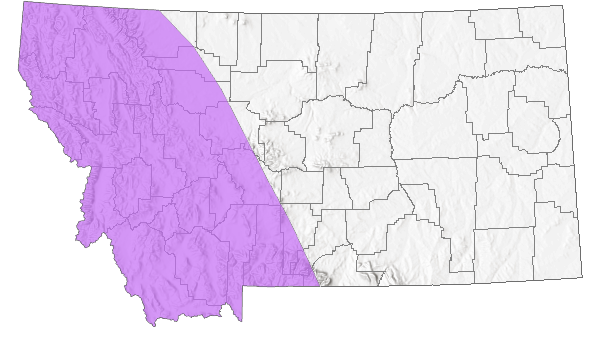
 Native
Native
Range Comments
From northern British Columbia south through Montana on both sides of the Continental Divide in the Rocky Mountains to northwestern Wyoming (Yellowstone National Park).
Observations in Montana Natural Heritage Program Database
Number of Observations: 8
(Click on the following maps and charts to see full sized version)
Map Help and Descriptions
Relative Density
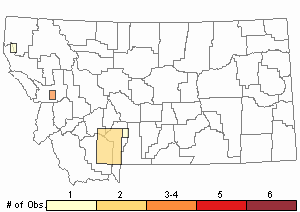
Recency
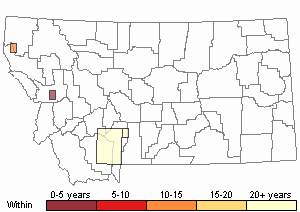

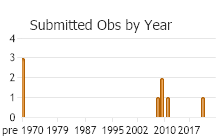
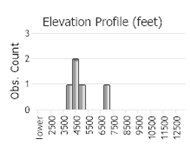 (Observations spanning multiple months or years are excluded from time charts)
(Observations spanning multiple months or years are excluded from time charts)
Migration
Not known to migrate. Length of movements not documented, but its ability to disperse is limited because the species is flightless.
Habitat
Grylloblatta campodeiformes is closely associated with high-elevation areas near snow-fields or glaciers that provide cold and moist conditions throughout the year. Often they occur in or under rock fields, where crevices provide suitable micro-climates in extreme summer or winter conditions, and this probably allows them to survive in lower-elevation forested sites (Engelmann spruce, subalpine fir, western redcedar, western hemlock, Douglas-fir). Deep moss layers, large logs, and dense vegetation may also create favorable microclimates at lower elevations (Silvestri 1931, Huggard and Klenner 2003). "Rock crawlers" have been reported in Montana from rock slides and under wood at low to moderate elevation sites (as low as 991 m, 3250 ft) supporting dense stands of such tree species as Douglas-fir and ponderosa pine, as well as treeless high-elevation alpine sites, such as the summit of McDonald Peak (2993 m, 9820 ft) in the Mission Mountains and Holland Peak (2852 m, 9356 ft) in the Swan Range (Mills and Pepper 1937, Pletsch 1947, Chapman 1953). Sometimes active on the surface of snow in winter (Gurney 1948, Paul Hendricks pers. obs.).
Food Habits
Little information. Captive adults were fed a diet of flies, white bread, and decaying plant matter obtained from moss and mulch (Mills and Pepper 1937). Immobile or dead flies were preferred to mobile ones, suggesting that Grylloblattids may prefer to scavenge animal matter. A more recent study from Alberta (Pritchard and Scholefield 1978) found mostly animal matter in autumn gut contents, which the authors concluded was not scavenged. Included were cold-adapted species (such as the flightless cranefly Chionea), as well as other Diptera families (Machilidae), Coleoptera (Staphylinidae), Homoptera (Aphidae), springtails (Collembolla), spiders (Oribatidae), and some vascular plant tissue. Captives were fed live flightless flies (Chionea, Drosophila).
Ecology
Cryophillic (cold-loving). Most active when the temperature is 1-15 C (34-59 F) and humidity is near 100% (Mills and Pepper 1937, Hensen 1957a, Jarvis and Whiting 2006). The mechanism of low temperature tolerance is unknown but not a result of significant amounts of glycerol, sorbitol or erythritol in the hemolymph (Morrissey and Edwards 1979). Rather than hibernating during winter, Grylloblattids are active throughout the year and probably move up or down through the substrate until they reach a favorable microclimate. Inactive individuals have been found in soils to a depth of 50 cm in August. During warmer periods they may be nocturnal when surface-active.
Reproductive Characteristics
Little information. Nymphs reported in late autumn, and copulation reported in late October in the Bozeman area (Pletsch 1947). Estimated lifespan is 5-10 years, largely due to low metabolism (Henson 1957b, Jarvis and Whiting 2006).
Management
Grylloblatids in south-central British Columbia appear to tolerate a wide range of forest management conditions (uncut, partial cut, smaller clearcut) in wetter forest sites, the exception being larger clearcuts with intensive site disturbance (Huggard and Klenner 2003). Stand replacement fire in areas currently occupied could make the thermal environment less favorable for sustaining populations.
Stewardship Responsibility
Threats or Limiting Factors
Identified as meriting IUCN Near Threatened status because of low vagility, small population sizes, and habitat threats (Jarvis and Whiting 2006); suitable forested habitat for this species may decline under warmer climate conditions.
References
- Literature Cited AboveLegend:
 View Online Publication
View Online Publication Chapman, J. 1953. Ecological notes on Gryllohatta in Montana. Proc. Mont. Acad. Sci. 13:39-43.
Chapman, J. 1953. Ecological notes on Gryllohatta in Montana. Proc. Mont. Acad. Sci. 13:39-43. Gurney, A.B., 1948. The taxonomy and distribution of the Grylloblattidae. Proc. Entomol. Soc. Wash. 50, 86-102.
Gurney, A.B., 1948. The taxonomy and distribution of the Grylloblattidae. Proc. Entomol. Soc. Wash. 50, 86-102. Henson, W.R. 1957. Temperature preference of (Grylloblatta campodeiformis) Walker. Nature 637: 179.
Henson, W.R. 1957. Temperature preference of (Grylloblatta campodeiformis) Walker. Nature 637: 179. Huggard, D.J., W. Klenner. 2003. Grylloblattids in managed forests of south-central British Columbia. Northwest Science 77: 12–18.
Huggard, D.J., W. Klenner. 2003. Grylloblattids in managed forests of south-central British Columbia. Northwest Science 77: 12–18. Jarvis, K.J. and M.F. Whiting. 2006. Phylogeny and biogeography of ice crawlers (Insecta: Grylloblattodea) based on six molecular loci: Designating conservation status for Grylloblattodea species. Molecular Phylogenetics and Evolution 41: 222–237.
Jarvis, K.J. and M.F. Whiting. 2006. Phylogeny and biogeography of ice crawlers (Insecta: Grylloblattodea) based on six molecular loci: Designating conservation status for Grylloblattodea species. Molecular Phylogenetics and Evolution 41: 222–237. Mills, Harlow B. and J.H. Pepper. 1937. Observations on (Grylloblatta campodeiformis) Walker. Annals of the Entomological Society of America, Vol. 30 pp. 269-275.
Mills, Harlow B. and J.H. Pepper. 1937. Observations on (Grylloblatta campodeiformis) Walker. Annals of the Entomological Society of America, Vol. 30 pp. 269-275. Morrissey, R. and J.S. Edwards. 1979. Neural function in an alpine grylloblattid: a comparison with the house cricket Acheta domesticus. Physiol. Entomol. 4, 241-250.
Morrissey, R. and J.S. Edwards. 1979. Neural function in an alpine grylloblattid: a comparison with the house cricket Acheta domesticus. Physiol. Entomol. 4, 241-250. Pletsch, D.J. 1947. The alpine rock crawler, (Grylloblatta campodeiformis) Walker, in Montana. Proceedings of the Montana Academy of Sciences 5–6: 17–20.
Pletsch, D.J. 1947. The alpine rock crawler, (Grylloblatta campodeiformis) Walker, in Montana. Proceedings of the Montana Academy of Sciences 5–6: 17–20. Pritchard, G. and P.Scholefield. 1978. Observations on food, feeding-behavior, and associated sense-organs of Grylloblatta campodeiformis (Grylloblattodea). Canadian Entomologist 110(2):205-212.
Pritchard, G. and P.Scholefield. 1978. Observations on food, feeding-behavior, and associated sense-organs of Grylloblatta campodeiformis (Grylloblattodea). Canadian Entomologist 110(2):205-212. Silvestri, F. 1931. Notes on (Grylloblatta campodeiformis) and a description of a new variety. Transactions of the American Entomological Society 57: 291–295.
Silvestri, F. 1931. Notes on (Grylloblatta campodeiformis) and a description of a new variety. Transactions of the American Entomological Society 57: 291–295.
- Additional ReferencesLegend:
 View Online Publication
View Online Publication
Do you know of a citation we're missing? Capinera, J.L., R.D. Scott, and T.J. Walker. 2004. Field Guide to Grasshoppers, Katydids, and Crickets of the United States. Ithaca, NY. Cornell University Press.
Capinera, J.L., R.D. Scott, and T.J. Walker. 2004. Field Guide to Grasshoppers, Katydids, and Crickets of the United States. Ithaca, NY. Cornell University Press. Scott, R.D. 2010. Montana Grasshoppers, Katydids, and Crickets A Pictorial Field Guide to the Orthoptera. MagpieMTGraphics, Billings, MT.
Scott, R.D. 2010. Montana Grasshoppers, Katydids, and Crickets A Pictorial Field Guide to the Orthoptera. MagpieMTGraphics, Billings, MT.
- Web Search Engines for Articles on "Northern Rock Crawler"
- Additional Sources of Information Related to "Insects"





